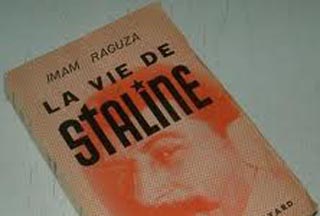
Who is Imam Raguza?

The luggage of an Armenian expatriate from Damascus Alexander Pashayan had lots of chests with books. It was the post-war period, where there was widespread destitution and starvation. None of the boys of the village would ever imagine that the chests that they stole actually contained books. But it was too late. The chests couldn’t be retrieved. So they had to burn the books.
Only one of the chests was saved, which had one anti-Stalin book, titled the “Life of Stalin,” which was published in 1938 in Paris and on the red cover there was the picture of Stalin. The author of the book was an unknown person named Imam Raguza. It would be hard to imagine what would happen to our family if this book was found in Batumi or even Armenia where my family was. In fact, my father himself didn’t know and wasn’t able to find out who Imam Raguza was. Ultimately, after protracted search, in late 1980s we were able to verify that Imam Raguza was Suren Yerznkyan, a publicist, a Soviet statesman, editor.
The ancestors of Suren Yerznkyan, as his last name prompts, were the renowned Yerznkyans, who moved to Haghpat from Tbilisi in the 18th century. But Suren was born in Tbilisi in 1981 to the family of a pastor Yeznik Yerznkyan. Suren Yerznkyan was indeed supposed to perfectly know Georgia as he studied in Nersisyan lyceum and knew Georgian very well. Later he studied in the universities of Moscow, Paris and Geneva. He was exiled to Siberia for his communist ideas. For some time he was even jailed in Metekhi prison of Tbilisi. After the establishment of the Soviet regime he was actively involved in publicity and editorial activities in Tbilisi till 1927. It is interesting that Suren Yerznkyan was entrusted a state job back then, which means that he was broad relationship with the prominent politicians of the country. In 1928-30 he was the Soviet delegate of trade to Finland.
However, in the 1930s, having felt the launching wave of repressions, Yerznkyan decides to quit the public service but was not allowed to do so. In 1930 he once again leaves for Finland again, where he makes an unexpected decision – not to return to the Soviet Union at all. Indeed, had he returned to the Soviet Union he was end up with the same tragic destiny of his cousin, prominent party activist Aramayis Yerznkyan, who was executed in 1937. There was a very painful circumstance for Yerznkyan. It was his children, who stayed in the Soviet Union – his daughter Maro, who later became one of our best scriptwriters and his son Saro, who perished in the aftermath of World War II. One of the famous nicknames of Suren Yerznkyan was Sar-Mar. Besides Finland Suren Yerznkyan also lived some time in France and was subsequently settled in Uppsala city of Sweden.
In one of the libraries of the city he accidentally gets introduced to the archives of a famous expert of Armenian studies Norayr Byuzandatsi. He then submits the tough but grateful job of studying his archives. In 1943 in Helsinki his books were published in Swedish and Finnish – “Kamo, Lenin’s friend, Stalin’s friend and my compatriot” in 1943, “The story of the Soviet cow” in 1943, Caucasus – my fatherland in 1944 and in 1945 again in Swedish his book “People’s tales of the Caucasus” were released. In Europe as well Yerznkyan continued networking with Armenian intelligentsia.
Suren Yerznkyan was one of the few Soviet politicians, who had the courage to write a book about Stalin when he was still alive. In 1945 in Swedish translation in Stockholm another book “Stalin and the Soviet Union” was released with a fake author name S. Lorelli. Both of the books best portrayed the Stalin era of the Soviet Union. In those books he also described the tools, which were used to debilitate the enemies of the Soviet Union. These facts are unprecedentedly interesting and valuable.
The author for example, explains the “method of selyodka,” which is used to get fake testimonies. They would feed the prisoner with a salty fish and keep him thirsty. In Sweden Yerznkyan married second time with a Swedish woman Yota Fley and lived with her till the end of his life in 1963. Yota Yerznkyan-Fley died about 40 years later by living with his memories. The bodies of the spouses are buried in the central cemetery of Uppsala. This is who Imam Raguza is, whose books were novelty for the then-Europe (where any kind of information about Stalin and the USSR were of value). But even now these books are read with interest and haven’t lost their political, cognitive meaning.























